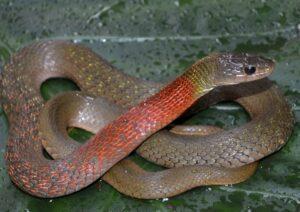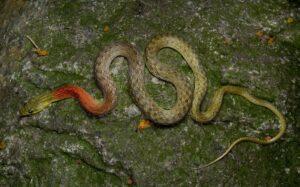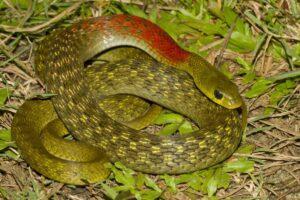The venomous red-necked keelback or red-necked keelback snake is endemic to Asia. Its specific name, ‘subminiatus’ refers to its characteristic reddish color limited to its neck or more extensive. ‘Miniatus’ is the Latin word for scarlet or vermillion. It is a medium-sized species with a moderately long, slender tail.
Scientific Classifications
- Suborder:Serpentes
- Family:Colubridae
- Genus:Rhabdophis
- Species:R. subminiatus
Conservation Status
Description
Size
The adults grow to a total length of 27.5-35.5 in (70-90 cm), including the tail.
Color and Appearance
The colubrid is greenish with yellow and red regions near its head. It is distinctly spotted and chequered with black or dark gray diffused blotches. A black or dark brown streak in the shape of a comma is usually present below the eye. Its belly is pale, in a cream or creamish-yellow color.
It is long and slender, with its head slightly bigger than its body. The slightly elongated head has a distinct brow ridge and large eyes with round pupils. The scales are strongly keeled.
Are They Dangerous to Humans
If disturbed, it tends to flatten its body, and any provocation or handling can lead it to strike.
There have been deaths and near-fatal conditions due to its bite. The Duvernoy’s gland located in its upper jaw releases a highly venomous secretion. The venom ducts open in its fangs, and a chewing action helps it in envenomation. Being rear-fanged, the snake needs to hold on to its bite or repeatedly bite to affect humans.
Its venomous bite causes internal hemorrhage (including brain hemorrhage), renal failure, coagulopathy, and even disseminated intravascular coagulation. But most biting cases have been attributed to its front teeth that don’t have any harmful effects. Deaths have only been caused in rare cases when they bit with their rear fangs. Nevertheless, it is very dangerous to get bitten by this snake, and only one weak anti-venom has been tested to date.
In addition to the venom, some snakes of this species (who eat poisonous toads) have poison stored in nuchal glands under the skin around their necks. If amply provoked, they present the back of the neck to the attacker from where poison is secreted.
Red-Necked Keelbacks at a Glance
Distribution
Widely distributed in southeast Asia, the snake is found in Thailand, Myanmar, Vietnam, Cambodia, Laos, northern India, southern China, peninsular Malaysia, Java, Borneo, and Sumatra.
Habitat
It usually lives near ponds for easy availability of its prey. It can also be found in paddy fields, wet forests, marshes, and grasslands in the vicinity of rivers and streams. The snake has also been spotted in or around rubber plantations.
The red-necked keelback is diurnal and terrestrial but can also be seen swimming.
Lifespan
The red-necked keelback snake has an average lifespan of 10 years.
Predators
The adults have no known predators, but the babies are eaten by large fish, birds, and bigger snakes.
Diet
The red-necked keelback eats frogs, toads, and fish.
Reproduction
Oviparous (lays eggs that hatch outside the body)
The eggs hatch around June, with the juveniles looking distinctly different from the adults. They have a hint of red on their necks and a prominent black band at the neck.
Source
indiabiodiversity.org, images.squarespace-cdn.com, bangkokherps.files.wordpress.com








